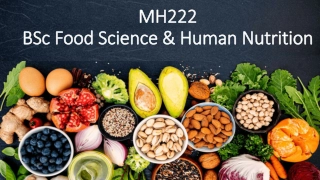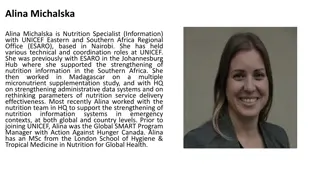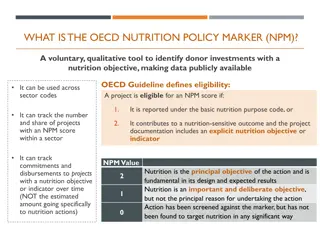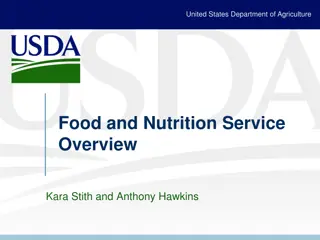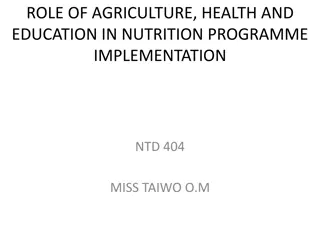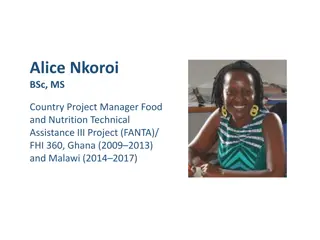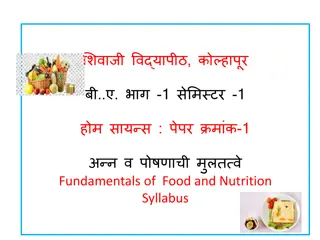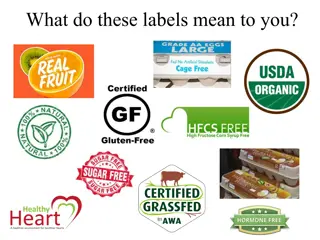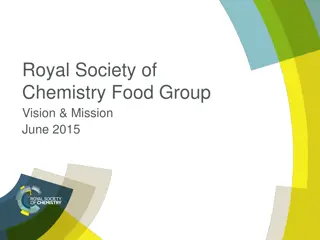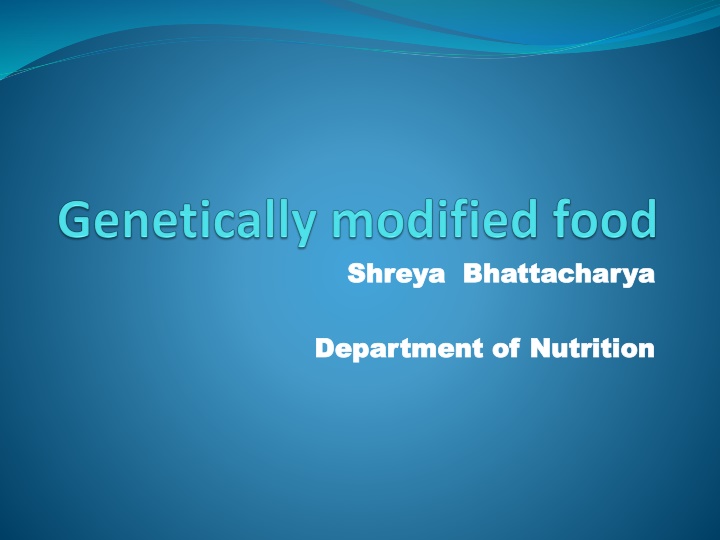
Genetically Modified Organisms and GE Foods
Explore the concept of genetically modified organisms (GMOs) and genetically engineered (GE) foods, including their definitions, techniques, and implications. Learn how GMOs are created through DNA alteration and how GE foods offer new traits and control over genetic characteristics. Dive into the shared DNA code, the process of inserting genes into GM plants, and the potential benefits and concerns surrounding genetically modified foods.
Download Presentation

Please find below an Image/Link to download the presentation.
The content on the website is provided AS IS for your information and personal use only. It may not be sold, licensed, or shared on other websites without obtaining consent from the author. If you encounter any issues during the download, it is possible that the publisher has removed the file from their server.
You are allowed to download the files provided on this website for personal or commercial use, subject to the condition that they are used lawfully. All files are the property of their respective owners.
The content on the website is provided AS IS for your information and personal use only. It may not be sold, licensed, or shared on other websites without obtaining consent from the author.
E N D
Presentation Transcript
Shreya Bhattacharya Shreya Bhattacharya Department of Nutrition Department of Nutrition
Concept Genetically modified organisms (GMOs) can be defined as organisms (i.e. plants, animals or microorganisms) in which the genetic material (DNA) has been altered in a way that does not occur naturally by mating and/or natural recombination. ... Foods produced from or using GM organisms are often referred to as GM foods.
Concept Of GE Foods Genetically modified foods (GM foods), also known as genetically engineered foods (GE foods), or bioengineered foods are foods produced from organisms that have had changes introduced into their DNA using the methods of genetic engineering. Genetic engineering techniques allow for the introduction of new traits as well as greater control over traits when compared to previous methods, such as selective breeding and mutation breeding
TECHNIQUE The shared DNA code Most organisms store their genetic information in the form of DNA molecules in chromosomes. The sequence of chemical bases in a DNA strand encodes a specific order of amino acids, which are the building blocks of proteins. Proteins carry out many functions in cells and tissues, which together are responsible for an organism s characteristics. Because most life forms share this same language of heredity and due to scientific advances in molecular biology it is now possible to transfer a gene from one species to another, for example from a bacterium to a plant, and have it function in its new host.
TECHNIQUE What is inserted into a GM plant? The inserted DNA fragment contains one or a few genes, which contain the DNA sequence information encoding specific proteins, along with DNA segments that regulate production of the proteins. The inserted fragment also sometimes contains a marker gene to easily identify plants that have incorporated the transferred genes, also known as transgenes, into their chromosomes.
TECHNIQUE How are transgenes inserted? There are two principal methods for transgene insertion: Gene gun: In this method, microscopic pellets of gold or tungsten are coated with the transgene fragment and shot at high velocity into plant cells or tissues. In a small proportion of cases, the pellet will pass through the cells and the DNA fragment will remain behind and become incorporated into a plant chromosome in the cell nucleus.
TECHNIQUE Agrobacterium tumefaciens: This method utilizes a biological vector, the soil dwelling bacterium Agrobacterium tumefaciens, which in nature transfers part of its DNA into plants and causes crown gall disease. Genetic engineers have taken advantage of this DNA transfer mechanism while disarming the disease- causing properties. Plant and bacterial cells are co- cultivated in a petri dish under conditions that facilitate gene transfer. This allows incorporation of genes in a more controlled manner than with the gene gun; however, it does not work equally well in all plant species.
TECHNIQUE How are whole plants obtained from plant cells or tissues? Insertion of transgenes is generally an inefficient process, with only a few percent of plant cells or tissues successfully integrating the foreign gene. Various strategies are used to identify the small percentage of cells/tissues that have actually been transformed. The next step is to develop those cells or tissues into whole plants capable of producing seed. This is done through a process called tissue culture, that is, growing plants on agar or a similar medium in the presence of plant nutrients and hormones under controlled environmental conditions.
TECHNIQUE What happens next? The crop developers then begin a long series of evaluations to determine that the gene has been incorporated successfully, that it is inherited in a stable and predictable manner, that the desired trait is expressed to the expected level, and that the plant does not show any negative effects. Evaluations are initially done in controlled greenhouses and growth chambers
TECHNIQUE Once sufficient seed is produced and the appropriate permission is received, experimental plants are grown in field trials. Field evaluations follow strict guidelines that include isolation from related plants to avoid cross-pollination, careful cleaning of planting and harvesting machinery, frequent monitoring of crop growth, and checking the field for two seasons after the trial for the presence of volunteer plants that have arisen from seed inadvertently left behind.
MORE EXAMPLES OF GM FOODS
What are potential GM crops of the future Some potential applications of GM crop technology are: Nutritional enhancement: Higher vitamin content; more healthful fatty acid profiles; Stress tolerance: Tolerance to high and low temperatures, salinity, and drought; Disease resistance: For example, orange trees resistant to citrus greening disease or American chestnut trees resistant to fungal blight; Biofuels: Plants with altered cell wall composition for more efficient conversion to ethanol; Phytoremediation: Plants that extract and concentrate contaminants like heavy metals from polluted sites.
Are GM crops grown in other countries? According to a recent report (James 2014), GM crops were grown in 26 other countries in 2013. The largest global acreage crops were soybean, corn, cotton, and canola, in that order. The U.S. has the greatest area of these crops, about 40% of the world total. Other large producers include Brazil, Argentina, India, and Canada.
Genetically Modified Crops Production globally
Steps adopted for acceptibility of GM Food The land area under cultivation with genetically modified organisms (GMOs) has grown steadily over the last two decades. Alleviation of the impacts of climate change and farmers adaptation are some of the arguments for GM crops. However, current systems of production, handling and transportation can lead to the unintentional low level presence of GMOs in non-GMO consignments. National policies and regulations that govern the acceptability of GM crops vary, and a number of traderelated problems have been reported as a result of the unintentional mixing of GM and non-GM crops. FAO conducted a survey to increase understanding of the extent of trade disruption due to the low level presence (LLP) and adventitious presence (AP) of GMOs.
Advantages and disadvantages Positive: Higher Productivity (food security), Resilience to climatic (drought resistance) and other related (pests, herbs, salinity) problems, less input use. Nutritionally enriched products
DisadvantageS Negative: Higher initial research and input (seed) cost, Concerns for health (human & animal), Environment concerns (loss of biodiversity, impact on non-target organisms), Unintentional gene transfer from GM to non-GM crops Low level presence and adventitious presence Limited access to GM seeds (Patenting),
DisadvantageS Lack of information for consumers (Labeling), Concerns of traditional farmers, ethical concerns, Lack of related regulations and technical capacities to detect GMOs in trade. 1Climate Change: Impact on Agriculture and Cost of Adaptation, IFPRI, 2009 An IFPRI Study (2009)1 found that even with no climate change world prices for many agricultural commodities (rice, wheat, maize) will increase by 39-63 % in 2050 driven by population, income growth, biofuels). Climate change (rise in temperature and change in rainfall patterns) results in additional price increases by 11-100 % even after CO2 fertilization effect.
REFERENCE: http://www.fao.org/ https://en.wikipedia.org/wiki/Genetically_m www.slideshare.net Information collected from different journals,books and other websites


